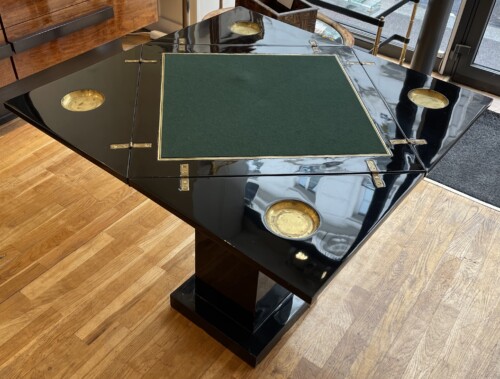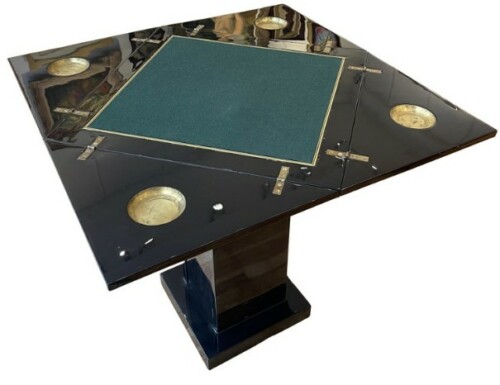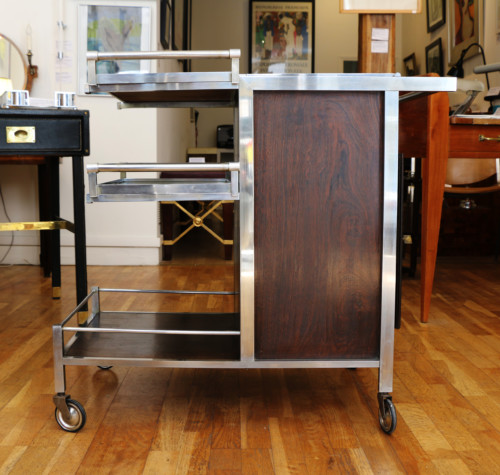René Joubert (1878–1931) et Philippe Petit (1900–1945) sont un duo de designers français ayant marqué le monde des arts décoratifs dans l’entre-deux-guerres. Actifs principalement dans les années 20 et 30, ils se sont distingués par un style mêlant élégance classique et modernité. Ils ont participé à plusieurs expositions internationales, dont l’Exposition des Arts Décoratifs de 1925 à Paris. Leurs œuvres ont souvent été éditées par la maison D.I.M. (Décoration Intérieure Moderne), crée par Joubert en 1918. Leur travail reflète une approche sobre et géométrique, caractéristique du mouvement Art Déco, tout en restant accessible à une clientèle bourgeoise en quête de modernité.
Table à jeu portefeuille
En bois laqué noir à système découvrant un plateau à jeu en velours vert et quatre cendriers en laiton
Piétement quadrangulaire ouvrant par une porte donnant sur un intérieur aménagé d’acajou et terminé par une base carrée
Editée par DIM (Décoration Intérieure Moderne)
Circa 1930
Dimensions
H : 72,5 cm ; L : 55 ; P : 55 cm (fermée)
H : 72,5 cm ; L : 78,5 cm ; P : 78,5 cm (ouverte)
René Joubert (1878–1931) and Philippe Petit (1900–1945) were a duo of French designers who made a significant impact on the world of decorative arts in the interwar period. Active mainly during the 1920s and 1930s, they stood out for a style that combined classical elegance with modernity. They took part in several international exhibitions, including the 1925 Exposition des Arts Décoratifs in Paris. Their works were often produced by the D.I.M. company (Décoration Intérieure Moderne), founded by Joubert in 1918. Their creations reflect a refined, geometric approach characteristic of the Art Deco movement, while remaining accessible to a bourgeois clientele in search of modernity.
Foldable Game Table
Black lacquered wood with a mechanism revealing a green velvet gaming surface and four brass ashtrays
Rectangular leg with a door opening onto an interior fitted in mahogany, with in a square base
Produced by DIM (Décoration Intérieure Moderne)
Circa 1930
Dimensions
H : 72,5 cm ; L : 55 ; D : 55 cm (closed)
H : 72,5 cm ; L : 78,5 cm ; D : 78,5 cm (open)
H : 28.5 in ; L : 21. 7 in ; D : 21.7 in (closed)
H : 28.5 in ; L : 30.9 in ; D : 30.9 in (open)
-
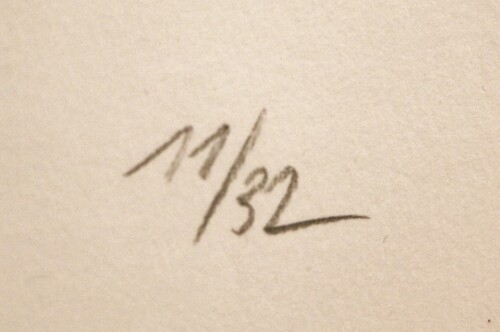
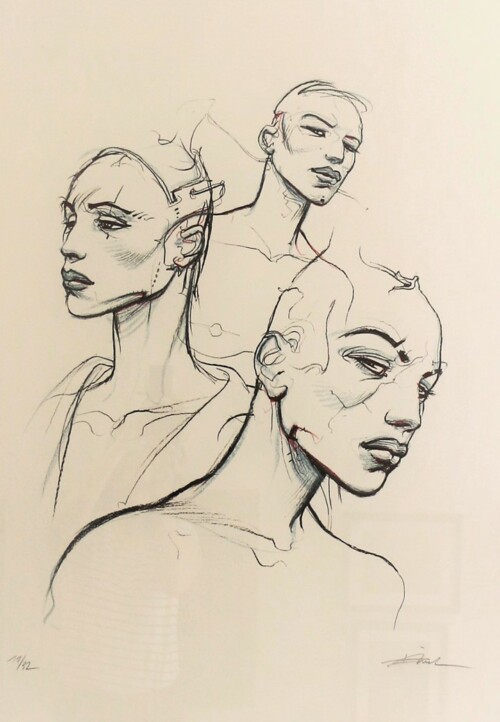 Enki Bilal (né le 7 octobre 1951 à Belgrade) est un auteur de bande dessinée et réalisateur français d'origine bosniaque et tchèque. Il est connu pour ses œuvres de science-fiction, abordant des thèmes comme le temps et la mémoire. Ses récits reflètent souvent des changements majeurs tels que la chute du communisme, l'extrémisme religieux et le changement climatique. En 1987, il reçoit le Grand Prix du festival d'Angoulême. La mémoire, personnelle et collective, est un thème central dans son œuvre, notamment dans la série Le Sommeil du Monstre. Sérigraphie rehaussée à la main à l'aquarelle et au pastel représentant trois bustes de femmes.
Enki Bilal (né le 7 octobre 1951 à Belgrade) est un auteur de bande dessinée et réalisateur français d'origine bosniaque et tchèque. Il est connu pour ses œuvres de science-fiction, abordant des thèmes comme le temps et la mémoire. Ses récits reflètent souvent des changements majeurs tels que la chute du communisme, l'extrémisme religieux et le changement climatique. En 1987, il reçoit le Grand Prix du festival d'Angoulême. La mémoire, personnelle et collective, est un thème central dans son œuvre, notamment dans la série Le Sommeil du Monstre. Sérigraphie rehaussée à la main à l'aquarelle et au pastel représentant trois bustes de femmes.- Tirage limité à 32 exemplaires.
- Signé en bas à droite.
- Numéroté 11/32.
_____________________________________________________________
Enki Bilal (born October 7, 1951, in Belgrade) is a French comic book author and filmmaker of Bosnian and Czech origin. Known for his science fiction works, he explores themes of time and memory. His stories often reflect on major societal shifts, like the fall of communism, religious extremism, and climate change. In 1987, he received the Grand Prix at the Angoulême Comics Festival. Memory, both personal and collective, plays a central role in his work, particularly in series like Le Sommeil du Monstre. A screenprint enhanced by hand with watercolor and pastel, depicting three female busts.- Each copy is unique.
- 11th out of 32 copies.
- Signed in the lower right.
-
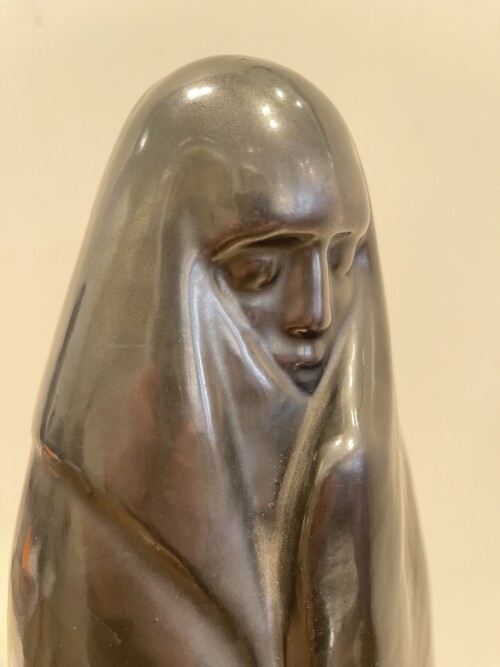
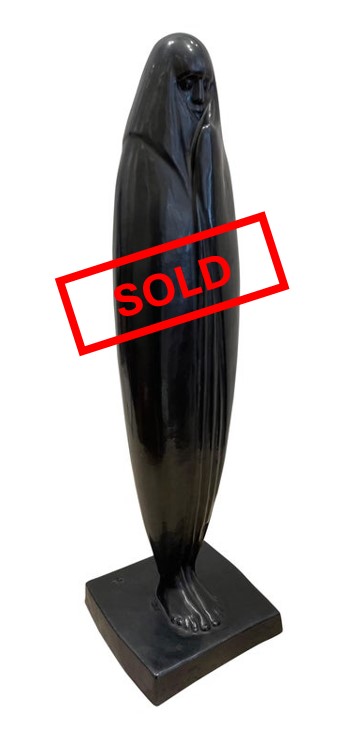 Superbe céramique émaillée de 72cm de haut par Céline Lepage (1882-1928), représentant une femme voilée de Marrakech (Maroc) des années 1920, époque Art Déco française. Elle est en terre cuite à patine gris anthracite et métallisée. Très bonne condition. Monogramme CL sur la base. Céline Lepage est une artiste française active au Maroc dans les années 1920. La "Dame voilée de Marrakech" est son chef-d'œuvre (elle existe en bronze et en terre cuite). Pour plus d'informations sur Lepage, cliquez ici Superb 72cm high glazed ceramic by Céline Lepage (1882-1928) representing a veiled lady from Marrakech (Morocco) in the 1920s, French Art Deco period. It is made of terracota with a grey anthracite and metallic patina. Very good condition. CL monogram on the base. Céline Lepage was a French artist active in Morocco in the 1920s. The "Veiled Lady from Marrakech" is her masterpiece (it exists in bronze and terracota). For more information about Lepage, click here
Superbe céramique émaillée de 72cm de haut par Céline Lepage (1882-1928), représentant une femme voilée de Marrakech (Maroc) des années 1920, époque Art Déco française. Elle est en terre cuite à patine gris anthracite et métallisée. Très bonne condition. Monogramme CL sur la base. Céline Lepage est une artiste française active au Maroc dans les années 1920. La "Dame voilée de Marrakech" est son chef-d'œuvre (elle existe en bronze et en terre cuite). Pour plus d'informations sur Lepage, cliquez ici Superb 72cm high glazed ceramic by Céline Lepage (1882-1928) representing a veiled lady from Marrakech (Morocco) in the 1920s, French Art Deco period. It is made of terracota with a grey anthracite and metallic patina. Very good condition. CL monogram on the base. Céline Lepage was a French artist active in Morocco in the 1920s. The "Veiled Lady from Marrakech" is her masterpiece (it exists in bronze and terracota). For more information about Lepage, click here -
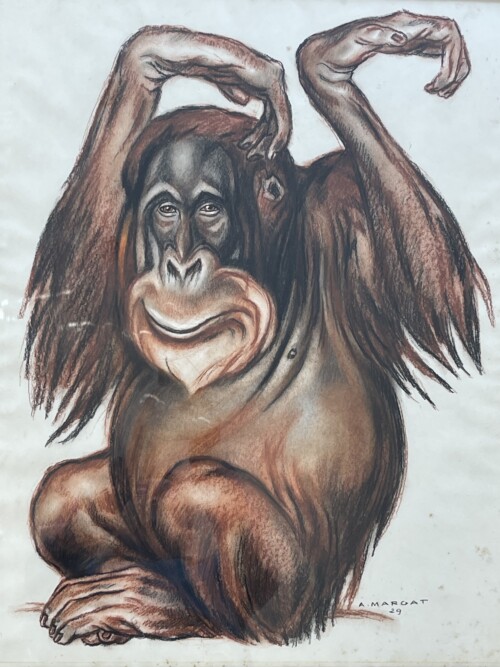
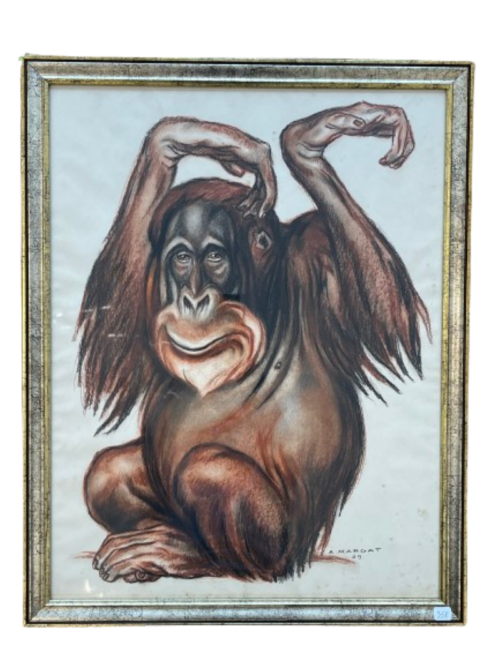 André Margat est un artiste français largement connu pour ses représentations d'animaux. Il est membre du « Groupe des Douze », une association d'artistes créée en 1932 dans le but de présenter l'art animalier français lors d'expositions et d'honorer un artiste chaque année.
André Margat est un artiste français largement connu pour ses représentations d'animaux. Il est membre du « Groupe des Douze », une association d'artistes créée en 1932 dans le but de présenter l'art animalier français lors d'expositions et d'honorer un artiste chaque année.- Dessin au pastel.
- Signé en bas à droite et daté (19)29.
- Drawing in pastel.
- Signed at lower right and dated (19)29.
-
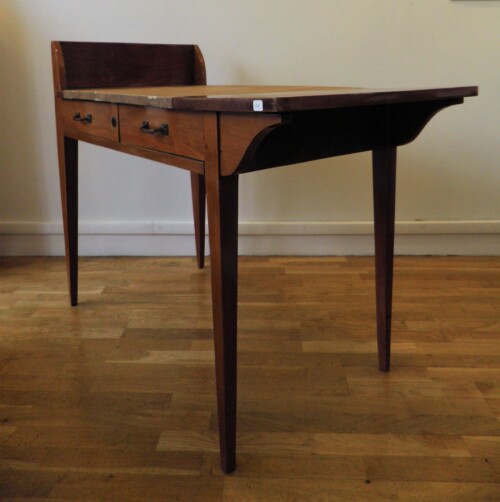
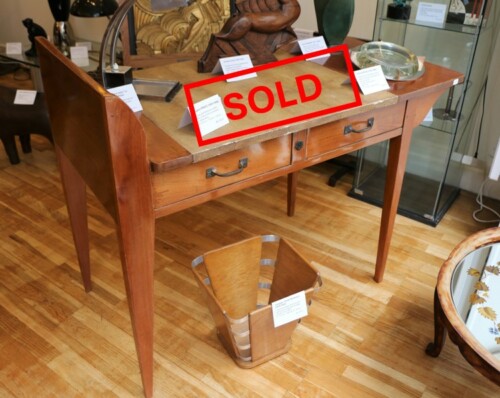 Eugène PRINTZ (1889-1948) Elégant bureau, dessiné par Printz pour la fameuse Cité Universitaire Internationale de Paris, de forme asymétrique, en acajou verni, ouvrant en façade par deux tiroirs. Les poignées sont en métal patiné et les plateau est recouvert d'un revêtement imitant le galuchat. Le bureau est dans son état original, et n'a jamais été restauré. La clef des tiroirs est manquante. Dans notre galerie se trouve aussi une étagère Printz destinée à la même résidence. 1930's H : 91 cm ; L : 113 cm ; P : 55 cm Pour plus d'informations sur le créateur, cliquer sur le nom : Eugène PRINTZ
Eugène PRINTZ (1889-1948) Elégant bureau, dessiné par Printz pour la fameuse Cité Universitaire Internationale de Paris, de forme asymétrique, en acajou verni, ouvrant en façade par deux tiroirs. Les poignées sont en métal patiné et les plateau est recouvert d'un revêtement imitant le galuchat. Le bureau est dans son état original, et n'a jamais été restauré. La clef des tiroirs est manquante. Dans notre galerie se trouve aussi une étagère Printz destinée à la même résidence. 1930's H : 91 cm ; L : 113 cm ; P : 55 cm Pour plus d'informations sur le créateur, cliquer sur le nom : Eugène PRINTZ
Art Déco wooden desk, by Eugène Printz. This asymmetric desk was designed by Eugène Printz (1889-1948) for the famous Cité Universitaire Internationale de Paris (a unique place where multiple residences - one per country - for international students were developped in the 1930's). It is made of varnished mahogany, has 2 drawers with patinated metal handles and is partly covered with canvas with a shagreen pattern. It is in its original condition and has not been restored. The drawer key is missing. The gallery has also in stock a matching book shelf which was also designed by Printz for the same residence. Dimensions : H : 35.83 in. ; W : 44.49 in. ; D : 21.65 in. H : 91 cm ; W : 113 cm ; D : 55 cm For more information : Eugène PRINTZ -
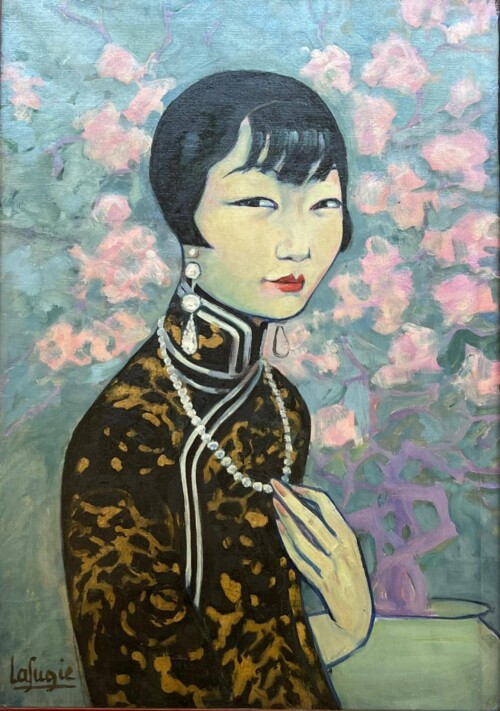
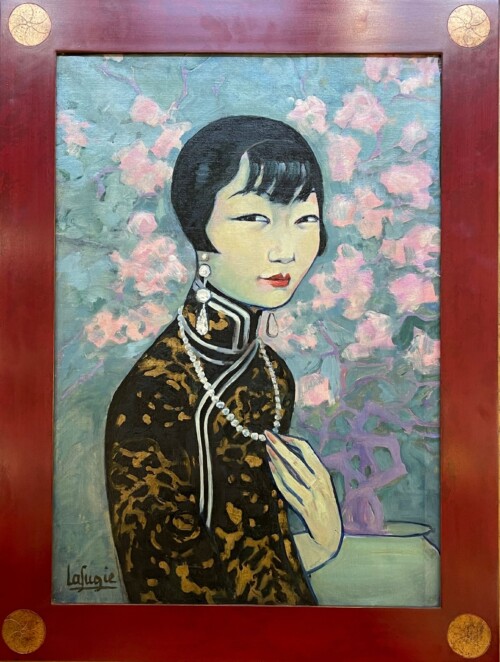 Léa Lafugie (1890-1972) est une peintre qui a voyagé à travers toute l’Asie. Elle est réputée pour ses portraits. Elle a étudié à l’École des Arts Décoratifs, puis à l’École des Beaux-Arts à Paris. Dotée d’un esprit aventurier et curieux, elle décide en 1925 de partir en voyage en Asie, notamment en Chine, en Inde, au Tibet, au Japon et sur la péninsule indochinoise. Elle a laissé de nombreux portraits féminins pris sur le vif lors de ses séjours. Femme de Shanghai Huile sur toile Petites restaurations d’usage et d’entretien Signée en bas à gauche Provient d’une collection privée de peintres français naturalistes Circa années 1920 Dimensions H : 65 cm ; L : 46,5 cm (sans cadre) H : 76,5 cm ; L : 57,5 cm (avec cadre)
Léa Lafugie (1890-1972) est une peintre qui a voyagé à travers toute l’Asie. Elle est réputée pour ses portraits. Elle a étudié à l’École des Arts Décoratifs, puis à l’École des Beaux-Arts à Paris. Dotée d’un esprit aventurier et curieux, elle décide en 1925 de partir en voyage en Asie, notamment en Chine, en Inde, au Tibet, au Japon et sur la péninsule indochinoise. Elle a laissé de nombreux portraits féminins pris sur le vif lors de ses séjours. Femme de Shanghai Huile sur toile Petites restaurations d’usage et d’entretien Signée en bas à gauche Provient d’une collection privée de peintres français naturalistes Circa années 1920 Dimensions H : 65 cm ; L : 46,5 cm (sans cadre) H : 76,5 cm ; L : 57,5 cm (avec cadre) -
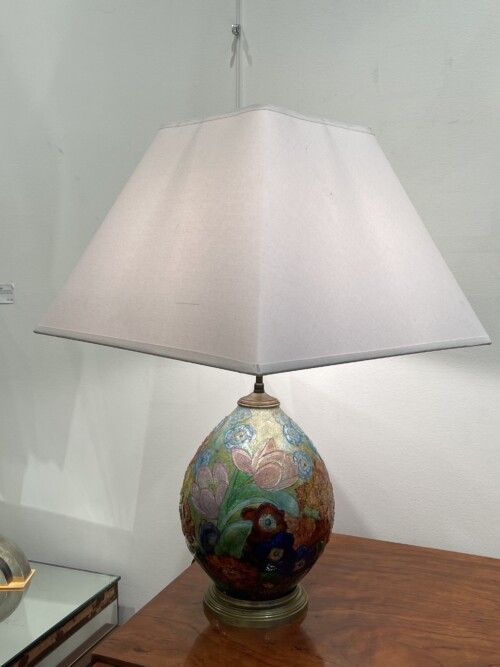
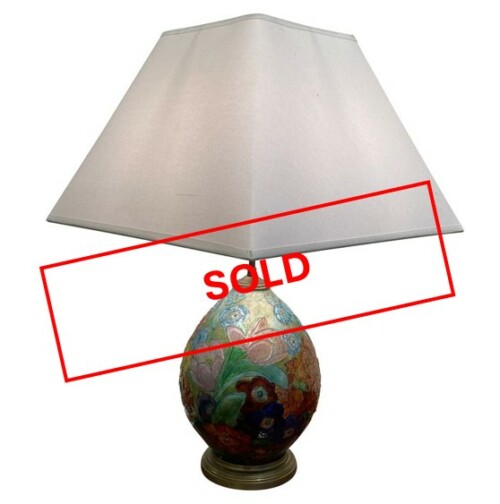
- Lampe de table prenant la forme d'un œuf en cuivre entièrement recouvert d'émail polychrome et translucide au décor floral.
- Montée sur une base et un collier en laiton.
- Signature Or habituelle dans l'émail en bas "C. Fauré Limoges".
- Electrifiée et câblée pour utilisation européenne.
- Table lamp shaped like an egg, entirely covered in colorful and translucent enamel with floral decoration.
- Mounted on a base and collar made of brass.
- Usual Gold signature in the enamel at the bottom "C. Fauré Limoges".
- Electrified and wired for European use.
-
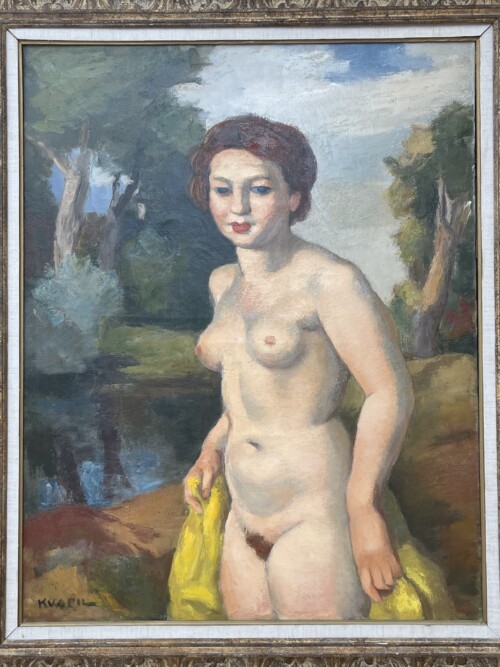
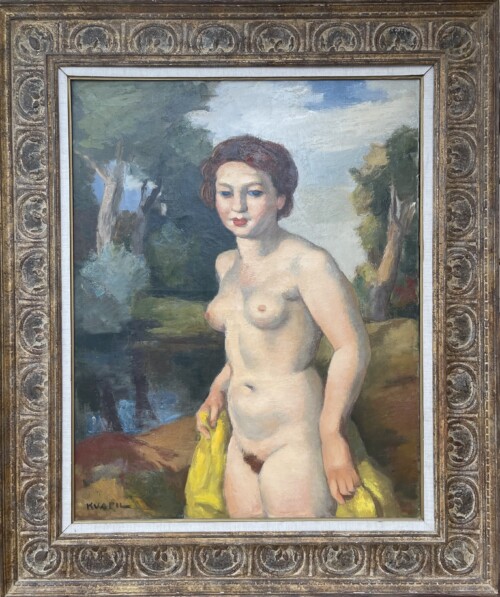 Charles Kvapil (1884-1957) était un peintre belge d’origine autrichienne, reconnu pour ses œuvres post-impressionnistes aux accents fauves. Né à Anvers, il étudie à l’Académie royale des beaux-arts d’Anvers puis à l’Académie Julian à Paris. Influencé par les maîtres impressionnistes et les courants modernes du début du XXe siècle, Kvapil développe un style personnel marqué par des couleurs vibrantes et une touche expressive. Il se spécialise dans les scènes de nus féminins, les portraits et les paysages, souvent baignés d'une lumière chaude et méditerranéenne. « Femme nue tenant un drapé jaune dans un paysage » Huile sur toile. Signée en bas à gauche. Circa 1930. Dimensions H : 91 cm ; L : 72 cm (sans cadre) H : 121,5 cm ; L : 102 cm (avec cadre)
Charles Kvapil (1884-1957) était un peintre belge d’origine autrichienne, reconnu pour ses œuvres post-impressionnistes aux accents fauves. Né à Anvers, il étudie à l’Académie royale des beaux-arts d’Anvers puis à l’Académie Julian à Paris. Influencé par les maîtres impressionnistes et les courants modernes du début du XXe siècle, Kvapil développe un style personnel marqué par des couleurs vibrantes et une touche expressive. Il se spécialise dans les scènes de nus féminins, les portraits et les paysages, souvent baignés d'une lumière chaude et méditerranéenne. « Femme nue tenant un drapé jaune dans un paysage » Huile sur toile. Signée en bas à gauche. Circa 1930. Dimensions H : 91 cm ; L : 72 cm (sans cadre) H : 121,5 cm ; L : 102 cm (avec cadre)
Charles Kvapil (1884–1957) was a Belgian painter of Austrian origin, known for his post-Impressionist works with Fauvist influences. Born in Antwerp, he studied at the Royal Academy of Fine Arts in Antwerp and later at the Académie Julian in Paris. Influenced by the Impressionist masters and the modern movements of the early 20th century, Kvapil developed a personal style characterized by vibrant colors and expressive brushwork. He specialized in scenes of female nudes, portraits, and landscapes, often bathed in warm, Mediterranean light. "Nude Woman Holding a Yellow Drape in a Landscape" Oil on canvas. Signed lower left. Circa 1930s. Dimensions H : 91 cm ; W : 72 cm (unframed) H : 121,5 cm ; W : 102 cm (framed) H : 35.8 in ; W : 28.3 in (unframed) H : 47.8 in ; W : 40.2 in (framed) -

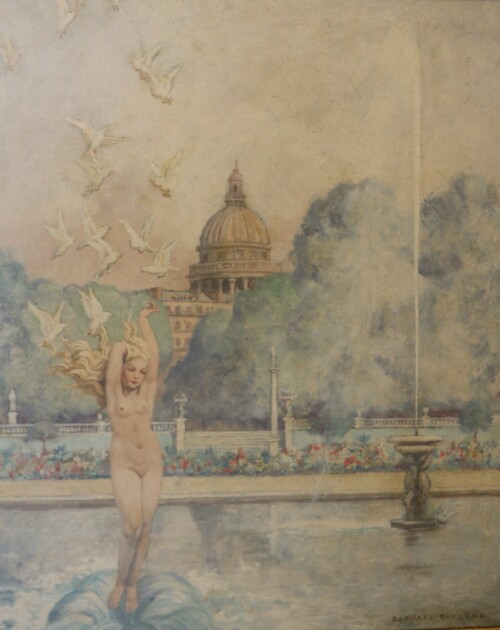 Raphael Delorme (1885-1962) fut l'un des principaux peintres de l'école de peinture bordelaise Art Déco, aux côtés de Dupas, en France dans les années 1920. Ce tableau est typique de son meilleur travail.
Raphael Delorme (1885-1962) fut l'un des principaux peintres de l'école de peinture bordelaise Art Déco, aux côtés de Dupas, en France dans les années 1920. Ce tableau est typique de son meilleur travail.- Signé en bas.
- Accompagné d'un certificat d'authenticité de l'expert Cécile Ritzenthaler.
Raphael Delorme (1885-1962) was one of the leading painter from the Art Deco Bordeaux school of painting with Dupas in France in the 1920's. This painting is typical of his best work.- Signed at the bottom.
- Accompanied by a certificate of authenticity from the expert Cecile Ritzenthaler.
-
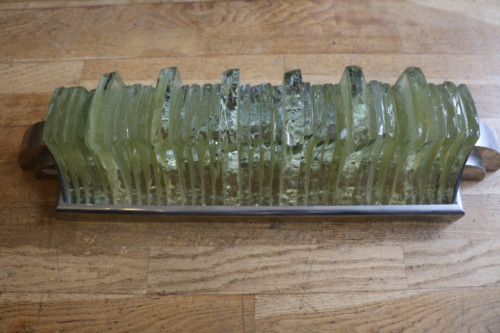
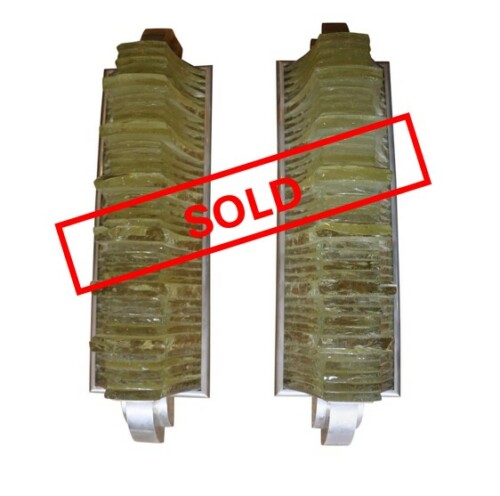 Jean Perzel (1892-1984) était un célèbre designer français de luminaires, né en Bavière. Après avoir été formé comme artiste verrier à Munich, il s’installe à Paris, où il se fait connaître pour ses élégants luminaires en verre et en bronze. En 1923, il établit son atelier et devient une figure clé du mouvement Art Déco, créant des designs pour des clients prestigieux comme la cour royale belge et Henry Ford. Son atelier est réputé pour son engagement envers l'artisanat, produisant des pièces telles qu'une lampe pivotante pour les étudiants et des dalles de verre incrustées de lumière. L'héritage familial se perpétue aujourd'hui sous la direction d'Olivier Raidt, le petit-neveu de Perzel, qui maintient la tradition d'un savoir-faire exceptionnel, reconnu par le label "Entreprise du Patrimoine Vivant".
Jean Perzel (1892-1984) était un célèbre designer français de luminaires, né en Bavière. Après avoir été formé comme artiste verrier à Munich, il s’installe à Paris, où il se fait connaître pour ses élégants luminaires en verre et en bronze. En 1923, il établit son atelier et devient une figure clé du mouvement Art Déco, créant des designs pour des clients prestigieux comme la cour royale belge et Henry Ford. Son atelier est réputé pour son engagement envers l'artisanat, produisant des pièces telles qu'une lampe pivotante pour les étudiants et des dalles de verre incrustées de lumière. L'héritage familial se perpétue aujourd'hui sous la direction d'Olivier Raidt, le petit-neveu de Perzel, qui maintient la tradition d'un savoir-faire exceptionnel, reconnu par le label "Entreprise du Patrimoine Vivant".- Métal nickelé et plaques de verre taillées au burin.
- Signées.
____________________________________________- Nickel-plated metal and chisel-cut glass plate.
- Signed.
-
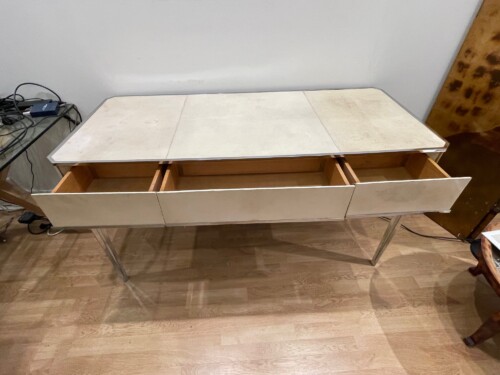
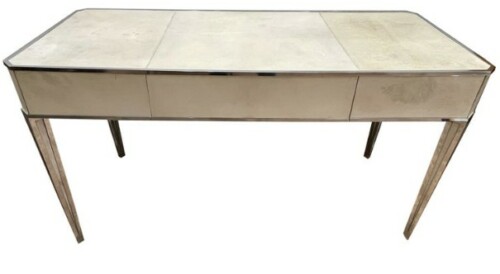 Superbe secrétaire Art Deco Primavera, fait d'une structure en bois de hêtre. Toutes les faces sont entièrement recouvertes d'un parchemin de cuir. Tous les angles sont renforcés par du métal chromé. Trois grands tiroirs occupent l'entièreté de la hauteur et de la profondeur du bureau, chacun disposant d'une séparation au milieu. Fait en France, dans les années 1930. Dimensions : L 141cm, l 61 cm, hauteur de 75cm. Pour plus d'informations sur Primavera, cliquez ici Superb Art Deco desk/secretaire by Primavera. It is made of a beech wood structure, all faces entirely covered with leather (parchment). All angles are reinforced with chromed metal. 3 large drawers which occupy the full length and depth of the desk, each with a middle separator. France, 1930's. Primavera was the famous Le Printemps department store high end design studio famous in the Art Deco period for its luxurious decoration objects and furniture. Dimensions : length 141cm, depth 61cm height 75cm. For more informations about Primavera click here
Superbe secrétaire Art Deco Primavera, fait d'une structure en bois de hêtre. Toutes les faces sont entièrement recouvertes d'un parchemin de cuir. Tous les angles sont renforcés par du métal chromé. Trois grands tiroirs occupent l'entièreté de la hauteur et de la profondeur du bureau, chacun disposant d'une séparation au milieu. Fait en France, dans les années 1930. Dimensions : L 141cm, l 61 cm, hauteur de 75cm. Pour plus d'informations sur Primavera, cliquez ici Superb Art Deco desk/secretaire by Primavera. It is made of a beech wood structure, all faces entirely covered with leather (parchment). All angles are reinforced with chromed metal. 3 large drawers which occupy the full length and depth of the desk, each with a middle separator. France, 1930's. Primavera was the famous Le Printemps department store high end design studio famous in the Art Deco period for its luxurious decoration objects and furniture. Dimensions : length 141cm, depth 61cm height 75cm. For more informations about Primavera click here
